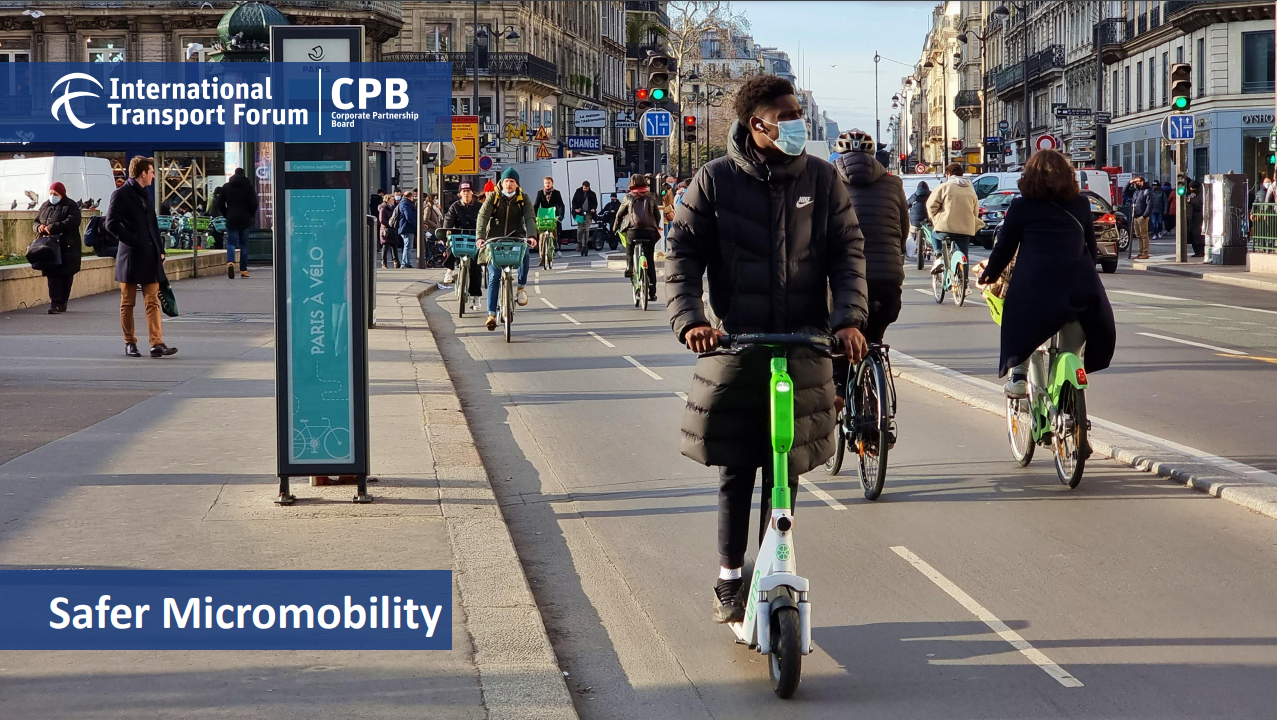The International Transport Forum (ITF) has recently published a new Report titled “Safer Micromobility“ co-authored by George Yannis, Virginia Petraki and Philippe Crist.
Micromobility provides viable options for car-free travel and improves connectivity to public transport, but it must be safe. The uptake of micromobility, boosted by the arrival of privately owned and shared e-scooters and e-bikes, benefits people and cities, but also raises challenges for safety within busy city spaces.
Micromobility is becoming safer, but an increase in severe injuries from e-scooter crashes is cause for concern. Overall, shared e-scooter casualty risk is on the decline in Europe, with usage increasing faster than reported injuries.
While incident data provides valuable insights into the frequency and severity of crashes, understanding micromobility safety requires an understanding of crash or injury risk. This means understanding how many crashes occur and relating this number to how much travel occurs. Outside of shared micromobility, we generally have fewer data on the overall number of bicycle, e-bike, and e-scooter trips taking place just as we see a significant under-reporting of crashes and injuries – especially non-severe injuries.
Assessing crash risk will require better data collection on trip numbers and crashes, as well as their severity for privately owned micromobility vehicles.
Micromobility crashes
Up to 70% of total reported casualties are minor. Severe injuries comprise a small portion of total reported casualties, and a relatively small percentage of reported micromobility crashes lead to fatal injuries (up to 1% of total reported casualties), with no clear difference between e-scooters, e-bikes, and conventional bikes.
Crash mechanisms vary based on the type of vehicle and road user involved. Most micromobility-related crashes involve only the rider and no other road users. These incidents are primarily attributed to falls, accounting for up to 93% of all reported escooter-related casualties. Collisions involving larger motor vehicles tend to result in more severe injuries, with as many as one in ten reported motor vehicle crashes involving e-scooters or bikes leading to severe injury or death of the rider involved. Motor vehicles are the greatest source of danger with respect to micromobility (and pedestrians) on urban streets.
E-scooter riders presented to hospitals with a greater share of head, face, and neck injuries than cyclists, which may partly be explained by significantly lower helmet use among e-scooter riders. E-scooter face injury profiles point to the need to explore escooter-specific helmet designs. Injuries to lower extremities are more prevalent among e-scooter riders than cyclists – possibly reflecting injuries sustained as e-scooter riders hop off their e-scooter just before or at the moment of losing control. Most injury categories are not mutually exclusive, and numerous patients presented with more than one injury type or location.
Safe infrastructure and vehicle design matter
Key risk factors associated with micromobility shed light on the multifaceted challenges that must be addressed to ensure the safe integration of micromobility options into urban landscapes.
An underlying risk factor for severe injuries and death of micromobility riders is the driving behaviour, speed, and mass of cars, vans, and trucks. Micromobilityfocused risk factors are related to rider behaviour, infrastructure, and vehicle design.
Rider-related safety factors differ significantly between bicycles and escooters, notably concerning night-time riding, alcohol intake, and helmet usage. Prominent causes of e-scooter riders’ injuries are riding under the influence of alcohol or drugs, low levels of helmet use and riding during night-time. Inexperienced riders, whether due to limited riding experience or unfamiliarity with local conditions, face heightened crash risks, with first-time riders particularly vulnerable. Speeding emerges as a significant concern, as excessive travel speed of micromobility modes and other motor vehicles has been identified as a key risk factor. This is especially the case for highspeed e-scooters and e-bikes (e.g. that can travel up to 45km/h). Addressing these rider-related factors is crucial for enhancing micromobility safety.
The growing popularity of micromobility, particularly of e-scooters, raises safety concerns related to their design. Unlike bikes, e-scooters entail a standing riding position, making riders vulnerable to falls, especially during abrupt manoeuvres. Reducing maximum design speed can significantly mitigate head-ground impact velocities during e-scooter falls. Wheel size and braking systems are critical factors affecting stability and crash outcomes, with larger wheels and effective braking systems enhancing safety. E-scooters differ from both e-bikes and traditional bicycles concerning their centre of gravity, acceleration profiles, and visibility features, influencing manoeuvrability and risk levels. Shared e-scooter fleets prioritise safety through design enhancements (dynamic geofenced speed controls, larger wheels, wider tyres, lower and more anterior frame/battery weight distribution, dual front and back braking, and wider foot platforms) and regular inspections, unlike privatelyowned counterparts.
Poorly maintained or unpaved surfaces contribute to rider loss of control and falls and are linked to heightened crash risk, particularly for e-scooters. Poor surfaces contribute to 30-40% of e-scooter crashes thus emphasising the critical need for smooth, comfortable, and well-maintained infrastructure to ensure rider safety. Riding location can also influence crash probability, with intersections and sidewalks the least safe locations due to high conflict rates. In the United States and Europe, the prevalence of micromobility infrastructure usage significantly affects safety outcomes, with separated infrastructure from car traffic proving the safest. Inappropriate parking of micromobility vehicles on sidewalks or pavements is a source of conflict and falls for pedestrians.
A focus on rider behaviour and safety equipment must be complemented by better infrastructure and improved vehicle design – especially for e-scooters.
Micromobility safety recommendations
A holistic approach that combines improved infrastructure, safe riding behaviour, vehicle design standards, and safety and exposure data collection is essential to improve micromobility safety. Subsequently, the following key recommendations based on the Safe System Approach for both Authorities and shared micromobility operators can contribute to further enhance micromobility safety.
Safe infrastructure
- Proactively maintain micromobility infrastructure (authorities)
- Establish a dedicated and wellconnected micromobility network (authorities)
- Establish a micromobility parking policy and designate parking areas where needed (authorities)
- Establish collaborative partnerships with authorities for infrastructure condition reporting (operators)
- Onboard parking zones in shared micromobility apps and deploy smart docking in high-traffic areas (operators)
Safe riders
- Implement a 30km/h (or lower) speed limit in areas with high micromobility use (authorities)
- Establish low-speed limits for micromobility vehicles in pedestrian or shared zones (authorities)
- Take enforcement action against risky micromobility (authorities)
- Promote the use of appropriate helmets (authorities) Introduce rider education in secondary schools (authorities)
- Enable real-time safety interventions via telematics (operators)
- Provide post-trip feedback via telematics data (operators)
- Provide economic incentives for safe riding (operators) Implement mandatory initial rider training (operators) Verify the age to start riding (operators)
Safe vehicles
- Set universal technical requirements for e-scooter design (authorities)
- Adopt riding support systems in micromobility vehicles (authorities)
- Ensure systematic maintenance of micromobility fleets (operators)
- Provide post-trip feedback via telematics data (operators)
- Enable context-dependent maximum speed control using geofencing (operators)
- Restrict e-scooter access if tandem riding and/or alcohol use is detected (operators)
- Implement riding support systems in shared e-scooters (operators)
Safe management
- Establish and collect data on distinct micromobility categories in safety statistics (authorities)
- Enable in-vehicle or in-app crash detection technology (operators)
Article in Cities in Motion, Polis Magazine in July 2024

